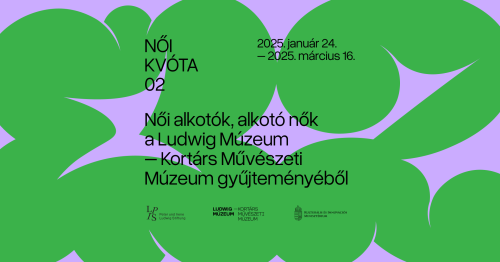Founded 35 years ago, the Ludwig Museum – Museum of Contemporary Art presents for the first time a selection of works from its collection made exclusively by women. The first section of the two-part exhibition focuses primarily on women’s roles and women’s (self-)representation in art, while the second section presents the genres and themes chosen by women, as well as their artistic achievements and accomplishments over the past fifty years, through their works in the museum.
The main wall in the first hall of Women’s Quota 01 featured portraits of women by men, while now, as a counterpoint, we see men through women’s eyes, singing about war, in military uniforms, in tanks, in the backdrop of burning houses – in line with the ancient allegory of Mars and Venus. In classical mythology, the male rivalry and the killing are brought to an end by Venus’ love: peace triumphs over war, love over hate. The home, the child, the family, as well as caring, nurturing and healing are important and prominent themes and motifs for women artists, inseparable from their life experiences and social roles – a rich selection of works that reflect this can be seen in the next hall.
“Feminine” themes, forms and techniques, feminist artistic practices, slowly earned their rightful place among the artistic experiments and trends of the mainstream of fine art. The artists of the post-war generation and of the 1960s and 1970s, such as Vera Molnár, Judit Reigl and Dóra Maurer, created their oeuvre in competition with men, while Ilona Keserü, the only female member of Iparterv, was the only one to use a formal language and colours that was unmistakably rooted in “womanhood”.
Among female artists, there are a striking number of “eccentric” artists who have created their oeuvre independently of current movements, following their own path and finding their own tools and forms of expression. In the new painting of the eighties – including in our museum’s collection – there are hardly any women artists. El Kazovsky’s art, which is closely linked to the artist’s transgenderism, is linked to the trends of the time through its personal mythology and theatricality.
Materials and forms linked to the body, the biological or male/female roles characterise the work of Ilona Lovas, who started out in textile art, the sculptor Mária Berhidi, or the next generation of artists, Mária Chilf and Mariann Imre. Neo-conceptual thinking can be seen in the sculptural experiments of Róza El-Hassan, Ágnes Deli or Valéria Sass, while at the same time artists such as Magda Csutak or Éva Köves explore the renewal and development of painting.
Kateřina Šedá’s or Ilona Németh’s projects represent the socio-political sensitivity of contemporary art, which has been on the rise in the 2000s, and present the life and story of a community, examining the situations and circumstances that define male and female roles. Finally, we will also present some of the women artists of the 2020s who are renewing today’s art with their unique techniques and striking experiments in colour and form (Zsófia Keresztes, Kata Tranker, etc.).
Curator: Krisztina Szipőcs
EXHIBITING ARTISTS
BARABÁS Zsófi, Ioana BĂTRÂNU, BERHIDI Mária, CHILF Mária, CSUTAK Magda, DELI Ágnes, Hélene DELPRAT, Marta DESKUR, EL-HASSAN Róza, EPERJESI Ágnes, GOSZTOLA Kitti, HAJDÚ Kinga, Flaka HALITI, HERMANN Ildi, Jenny HOLZER – LADY PINK, IMRE Mariann, Valerie JAUDON, KÁLDI Katalin, El KAZOVSZKIJ, KERESZTES Zsófia, KESERÜ Ilona, Lesia KHOMENKO, KINDER ALBUM, KORTMANN-JÁRAY Katalin, KOVÁCS Lola, KÖVES Éva, Anne LOCH, LOVAS Ilona, Kateryna LYSOVENKO, MAKAI Mira, MAURER Dóra, Vera MOLNAR, NÉMETH Hajnal, NÉMETH Ilona, Yoko ONO, REIGL Judit, SASS Valéria, Kateřina ŠEDÁ, SIMONYI Emő, SZABÓ Dorottya, SZÁSZ Lilla, SZÉCHY Beáta, SZÉPFALVI Ágnes, TRANKER Kata, VOJNICH Erzsébet
Download the exhibition booklet HERE.























